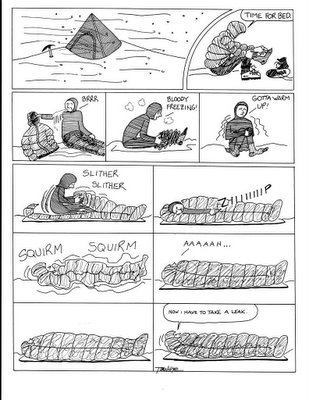This could almost be called Knocked Off a Classic, but I'm getting ahead of the story.
I met a New Zealander named Steve Gunn one November afternoon on the Middle Sister, the next peak over from Chocorua. He was going to be living and working in the Boston area for a year or two, and wanted to make some connections up here in New Hampshire for hiking and climbing. Looking at his weatherbeaten rucksack with the New Zealand flag patch on it, I figured him for some steely-eyed alpinist. I planned to introduce him to the guiding crowd in North Conway, where he would find companions for the hardest, most spectacular routes the area has to offer. But he turned out to be merely human after all, so we ended up doing a lot of routes together.
We started ice season that year with a pleasant unroped jaunt up Central Gully on the headwall of Huntington Ravine. We even proceeded to the summit and enjoyed a sobering grope through the windy whiteout on our way down, when we wandered off the Lion Head Trail on the upper reaches of the rockpile. No worries, though, we just tacked back and forth on our way down, on a general compass heading for the top of Tuckerman Ravine and found the cairns again. Everybody stay calm, nobody gets hurt.
After fun ascents of Standard Route on Frankenstein, Hitchcock Gully on Mount Willard, Willey's Slide and others, we chose to finish up with Pinnacle Gully on a beautiful March Saturday.
Everyone likes to do Pinnacle Gully on a beautiful March Saturday. And most of them were in line ahead of us.
By this point in the season we had our routines established. Steve wanted to lead the first pitch. I would lead past him to the next belay stance.
NEice.com says the route is 500 feet and uses fixed belays in the rock along the left wall. I swear I don't remember swinging leads more than once, making the part we did on rope just over 300 feet. We also used only one set of fixed anchors, from which I belayed Steve as he led the first pitch.
What I do remember is an unwieldy group of about five climbers with huge packs, who got onto the route ahead of us, and a freewheeling group of solo climbers dashing up it ropeless.
The large group had put a couple of climbers on the face, but time was a-wasting. Steve decided to start up anyway, winging over to the right to head up a fairly steep bulge. I hunkered in the partial shelter of jutting rocks as chunks of ice rained down from the slashing tools of the climbers above.
Steve made quick work of the first rope length. I disassembled the belay and scampered across the line of fire to get into the passing lane. Then I sprinted up to Steve, where we traded some hardware back and forth so I could head up the next pitch.
One of the soloists came by with a cheery greeting. He was climbing very cleanly, with a minimum of fallout.
I headed on up as the gully narrowed, then widened again. I hung a left onto a broad area at the top of the pitch, where I could set a comfortable belay. In typical ice climbing fashion, I had chilled as I belayed, then heated up steamily on the actual climb.
I signaled that the belay was ready. Steve was out of sight, so I was fishing for him, sensing through the rope when he needed slack taken up. It seemed to be taking a long time. Then I heard a loud shout. When I called down, I got no answer, but the rope continued to slacken, indicating he was climbing, though not so much as to indicate that he was no longer on the end of it.
When Steve arrived, he told me that one of the heavily loaded climbers had dropped his enormous pack on one of the soloists. The unroped soloist had stayed on the face as the pack hurtled by him, hitting the talus slope and blowing apart as it tumbled and slid hundreds of feet below the bottom of the climb. The slow group had to downclimb from the route and then climb down further to retrieve the exploded pack and its scattered contents.
Just another day on a popular classic.

